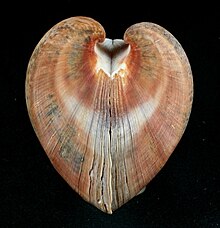In anatomy, an apex is part of the shell of a mollusk. The apex is the pointed tip of the shell of a gastropod, scaphopod, or cephalopod.

Atrina fragilis, the fan mussel, is a species of large saltwater clam, a marine bivalve mollusc in the family Pinnidae, the pen shells.
A valve is each articulating part of the shell of a mollusc or another multi-shelled animal such as brachiopods and some crustaceans. Each part is known as a valve or in the case of chitons, a "plate". Members of two classes of molluscs, the Bivalvia (clams) and the Polyplacophora (chitons), have valves.

A bivalve shell is part of the body, the exoskeleton or shell, of a bivalve mollusk. In life, the shell of this class of mollusks is composed of two hinged parts or valves. Bivalves are very common in essentially all aquatic locales, including saltwater, brackish water, and freshwater. The shells of bivalves commonly wash up on beaches and along the edges of lakes, rivers, and streams. Bivalves by definition possess two shells or valves, a "right valve" and a "left valve", that are joined by a ligament. The two valves usually articulate with one another using structures known as "teeth" which are situated along the hinge line. In many bivalve shells, the two valves are symmetrical along the hinge line—when truly symmetrical, such an animal is said to be equivalved; if the valves vary from each other in size or shape, inequivalved. If symmetrical front-to-back, the valves are said to be equilateral, and are otherwise considered inequilateral.
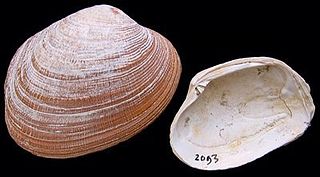
The grooved carpet shell, or Palourde clam, Ruditapes decussatus, or Venerupis decussatus, is a clam in the family Veneridae. It is distributed worldwide and due to its ecological and economic interest has been proposed as a bioindicator.

Mya truncata, common name the blunt gaper or truncate softshell, is a species of edible saltwater clam, a marine bivalve mollusk in the family Myidae.

Astarte borealis, or the northern astarte, is a species of bivalve mollusc in the family Astartidae. It can be found along the Atlantic coast of North America, ranging from Greenland to Massachusetts.
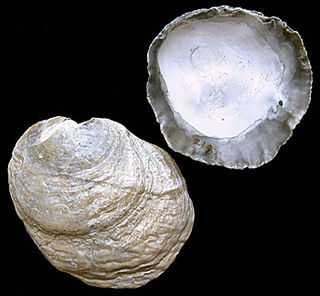
Pododesmus patelliformis, the ribbed saddle-oyster, is a species of bivalve mollusc in the family Anomiidae. It is found in the north east Atlantic Ocean.
Pojetaia is an extinct genus of early bivalves, one of two genera in the extinct family Fordillidae. The genus is known solely from Early to Middle Cambrian fossils found in North America, Greenland, Europe, North Africa, Asia, and Australia. The genus currently contains two accepted species, Pojetaia runnegari, the type species, and Pojetaia sarhroensis, though up to seven species have been proposed. The genera Buluniella, Jellia, and Oryzoconcha are all considered synonyms of Pojetaia.
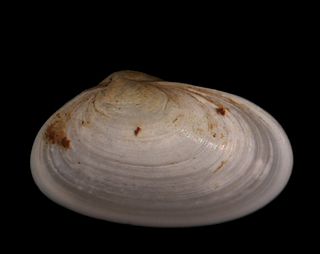
Tellimya ferruginosa is a species of small marine bivalve mollusc in the family Lasaeidae. It is found on the eastern side of the Atlantic Ocean.
Phaxas pellucidus, the transparent razor shell, is a species of marine bivalve mollusc in the family Pharidae. It is found buried in the seabed in coastal waters of northwest Europe, often in great numbers.

Fordilloidea is an extinct superfamily of early bivalves containing two described families, Fordillidae and Camyidae and the only superfamily in the order Fordillida. The superfamily is known from fossils of early to middle Cambrian age found in North America, Greenland, Europe, the Middle East, Asia, and Australia. Fordillidae currently contains two genera, Fordilla and Pojetaia each with up to three described species while Camyidae only contains a single genus Camya with one described species, Camya asy. Due to the size and age of the fossil specimens, Fordillidae species are included as part of the Turkish Small shelly fauna.
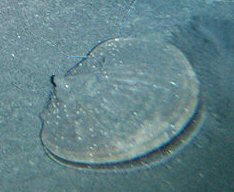
The Antarctic scallop is a species of bivalve mollusc in the large family of scallops, the Pectinidae. It was thought to be the only species in the genus Adamussium until an extinct Pliocene species was described in 2016. Its exact relationship to other members of the Pectinidae is unclear. It is found in the ice-cold seas surrounding Antarctica, sometimes at great depths.

Venerupis corrugata, the pullet carpet shell, is a species of bivalve mollusc in the family Veneridae. It is found buried in the sediment on the sea bed in shallow parts of the eastern Atlantic Ocean. It is harvested for human consumption in Spain and other parts of Western Europe.

Hinge teeth are part of the anatomical structure of the inner surface of a bivalve shell, i.e. the shell of a bivalve mollusk. Bivalves by definition have two valves, which are joined together by a strong and flexible ligament situated on the hinge line at the dorsal edge of the shell. In life, the shell needs to be able to open slightly to allow the foot and siphons to protrude, and then close again, without the valves moving out of alignment with one another. To make this possible, in most cases the two valves are articulated using an arrangement of structures known as hinge teeth. Like the ligament, the hinge teeth are also situated along the hinge line of the shell, in most cases.

A prodissoconch is an embryonic or larval shell which is present in the larva of a bivalve mollusk. The prodissoconch is often but not always smooth, and has no growth lines. It is sometimes still present and visible in the adult shell, if there has been no erosion of the shell in that area.
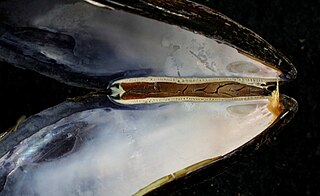
A hinge ligament is a crucial part of the anatomical structure of a bivalve shell, i.e. the shell of a bivalve mollusk. The shell of a bivalve has two valves and these are joined together by the ligament at the dorsal edge of the shell. The ligament is made of a strong, flexible and elastic, fibrous, proteinaceous material which is usually pale brown, dark brown or black in color.

The adductor muscles are the main muscular system in bivalve mollusks. In many parts of the world, when people eat scallops, the adductor muscles are the only part of the animal which is eaten. Adductor muscles leave noticeable scars or marks on the interior of the shell's valves. Those marks are often used by scientists who are in the process of identifying empty shells to determine their correct taxonomic placement.
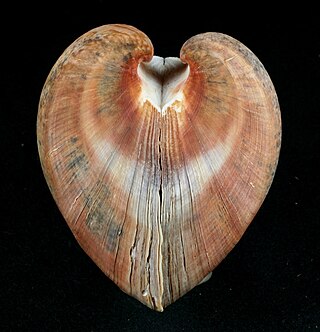
The beak is part of the shell of a bivalve mollusk, i.e. part of the shell of a saltwater or freshwater clam. The beak is the basal projection of the oldest part of the valve of the adult animal. The beak usually, but not always, coincides with the umbo, the highest and most prominent point on the valve. Because by definition, all bivalves have two valves, the shell of a bivalve has two umbones, and two beaks.

A lunule is an anatomical feature which is found in the exterior surface of the shells of some species of clams, bivalve mollusks, as for example in the family Veneridae and in the genus Ascetoaxinus.


